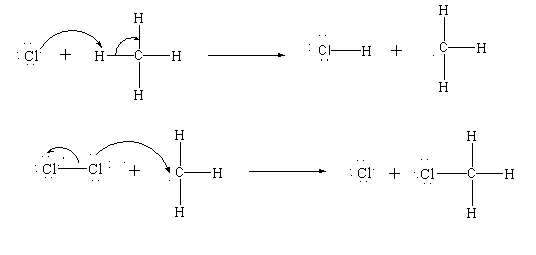
Answer
427.2k+ views
Hint:Constitutional isomers also known as structural isomers are compounds which possess the same molecular formula but differ in their structural formula. In the compound ${C_7}{H_{15}}Cl$, three types of hydrogen bonding are present.
Complete step by step answer:Free radical halogenation reaction:
The free radical halogenation reaction is a type of halogenation reaction where single hydrogen of the alkane is replaced by the single halogen to form a haloalkane. This reaction takes place in presence of light.
This reaction has three steps.
Step 1: Initiation
In this step the halogen molecule breaks down in presence of light to give free radicals.

Step 2: Propagation
The propagation step is divided further in two steps. In the first propagation step, the chlorine radical attacks the hydrogen atom present in the methane and forms hydrochloric acid and a methyl radical.

In the second propagation step more chlorine is added, out of which one chlorine atom becomes free radical and others get attached to the methyl radical.
Step 3: Termination
In the last step, the remaining free radicals combine with each other to generate new products like chloromethane and the two methyl radicals generate the by-product to form ethane.

Note:
In free radical halogenation reaction, energy or light source is only needed in the first step that is initiation to break the halogen molecule into free radical. After that all the further reaction can be processed without any energy source.
Complete step by step answer:Free radical halogenation reaction:
The free radical halogenation reaction is a type of halogenation reaction where single hydrogen of the alkane is replaced by the single halogen to form a haloalkane. This reaction takes place in presence of light.
This reaction has three steps.
Step 1: Initiation
In this step the halogen molecule breaks down in presence of light to give free radicals.

Step 2: Propagation
The propagation step is divided further in two steps. In the first propagation step, the chlorine radical attacks the hydrogen atom present in the methane and forms hydrochloric acid and a methyl radical.

In the second propagation step more chlorine is added, out of which one chlorine atom becomes free radical and others get attached to the methyl radical.
Step 3: Termination
In the last step, the remaining free radicals combine with each other to generate new products like chloromethane and the two methyl radicals generate the by-product to form ethane.

Note:
In free radical halogenation reaction, energy or light source is only needed in the first step that is initiation to break the halogen molecule into free radical. After that all the further reaction can be processed without any energy source.
Recently Updated Pages
Identify the feminine gender noun from the given sentence class 10 english CBSE

Your club organized a blood donation camp in your city class 10 english CBSE

Choose the correct meaning of the idiomphrase from class 10 english CBSE

Identify the neuter gender noun from the given sentence class 10 english CBSE

Choose the word which best expresses the meaning of class 10 english CBSE

Choose the word which is closest to the opposite in class 10 english CBSE

Trending doubts
Which of the following is the capital of the union class 9 social science CBSE

Fill the blanks with the suitable prepositions 1 The class 9 english CBSE

Name the metals of the coins Tanka Shashgani and Jital class 6 social science CBSE

Which are the Top 10 Largest Countries of the World?

How do you graph the function fx 4x class 9 maths CBSE

The Equation xxx + 2 is Satisfied when x is Equal to Class 10 Maths

Change the following sentences into negative and interrogative class 10 english CBSE

Difference between Prokaryotic cell and Eukaryotic class 11 biology CBSE

10 examples of friction in our daily life




